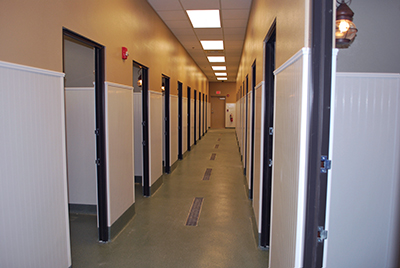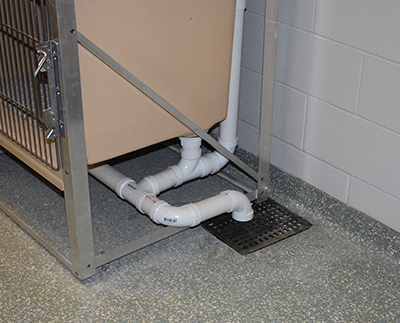
Drains
More Than a Hole in the Floor
By Rick Bacon, AIA
Drains require forethought.
Will the drain be a people drain? A cat drain? A dog drain? A rain drain? How do you intend to get water in the drain or other stuff out of the drain? Some drains end up draining money, and some end up draining nothing. What kind of floor drain you have, where to put it, and where it leads depends on what is intended to go (or not go) down that drain.
The drainage design is linked with your cleaning protocol and to your general aesthetic. In most boarding facilities, it is understood that staff is supposed to pick up solid waste as soon as it is seen whether in the suite, in a walkway, or outside in the exercise areas. We all know that tidy housekeeping makes a good impression and reduces odors and the potential for disease transmission. If you have or want suites with no floor drains, then it is understood that the suites are cleaned by mop and bucket and in a manner that reduces the animals being exposed to their mess. The cleaning protocols have a direct relation to the need for, the type of, and location of drains used for cleaning.

Trench drains positioned in the walkway between individual dog suites allow for periodic cleaning without placing a floor or trench drain inside each suite. Notice how the resinous floor finish is coved up the walls at the base to minimize water damage and reduce crevasses where dirt and germs can accumulate. These suites are not designed to undergo heavy cleaning with water and chemicals on a regular basis, or the aluminum doors (not installed yet) and door frames would deteriorate. (Photo by Bacon Group, Inc.)
Dog Drains
Drains in dog housing areas come in two basic types: single floor drain or some kind of trench drain. In boarding facilities that offer built-in suites for the dogs, the use of individual “standard” drains will be considered. If individual drains are desired in each suite, consider the square or round individual drain. I prefer the square drain; it works better if the flooring is to have a tile finish. Cutting tile around the round drain can be difficult. Don’t hesitate to over-size the drain. 3” and 4” diameter drains are fairly standard in restrooms, so consider oversizing to 6” to 8” diameter drain; the cost isn’t that much more. Of course the underground piping will need to be increased, also. The increased size will help avoid the drains and piping getting stopped up.
In most cases with suites that have drains, the concrete and finish material will slope to the drain. Where the drain is located will need to be pre-determined so the design can reflect the location and the proper floor slope. A drain in the center of the space is the easiest to construct. Make sure that the perimeter elevation at the walls is uniform. If you want to hide the drain, say under a dog resting bed, then the floor slope will vary and will be more difficult for the concrete installer.
Trench drains are also a consideration, even though I haven’t included them for the individual suites in boarding facilities very often. Trench drains are used extensively in animal shelters that require heavier cleaning every day. You will find a variety of opinions about the best type and location of trench drains. I prefer to place them at the rear of the space which helps staff clean from front to back. I don’t like open trench drains, especially in the walkway or in the front of the kennel or suite. I consider them less attractive and a trip hazard, and they require that staff clean toward the front of the suite and walkway.

Modular cages and kennels come with built-in drainage systems, so they are good choices when you can’t have or don’t want lots of floor drains. It is important to coordinate room size and floor drain location with equipment space requirements. The rear leg of this cage unit sits on top of the drain cover, which will make it harder to service the drain. (Photo by Bacon Group, Inc.)
A compromise is installing a trench drain in the walkway between suites for occasional spring cleaning. The suites are hosed as appropriate, and water is pushed to the walkway. The trench drains are sized to handle the amount of water anticipated. It will still be necessary to slope the floors toward the trench drain. However, if you want to do frequent or daily cleaning using a low pressure spray-wash system and intend to squeegee water to the drain, I recommend an individual or trench drain be placed in each dog suite or kennel.
Really think about the need for a drain at all in your dog suites. In many cases, it was decided that simple mopping and squeegeeing is all that would be required for routine cleaning. The heavier and more intensive cleaning will be done infrequently, thus negating the expense of installing drains in every suite. We designed a facility where the owner decided not to put drains in the suites. The protocol was to take the dogs out to the exercise and elimination areas at least three times a day, which reduced the amount of cleaning dramatically. It eliminated a lot of drains, and sloping of the floors was not as critical. In addition, the building system was tilt-up wall construction, and without the sloped floors, the panels could be more easily formed on site. Only floor drains were installed intermittently in the walkways.
Cat Drains
I don’t recommend any drains in catteries. If cat litter gets in the drain and piping and gets wet for any reason, it will solidify similar to plaster of Paris. If you want floor drains in your cattery, be aware of this potential maintenance headache.
Drain Covers
Always include drain covers. Also remember to consider the size of the slots in the drain cover in relation to the size dog to be boarded in that space. I have heard too many stories of dog claws getting stuck in the drain cover. Also anticipate having to replace the drain covers. Staff will have a tendency to lose the covers during maintenance, so buy extra covers. Lastly, make sure that you can actually remove the drain covers. You need to have the contractor demonstrate that the cover can be removed and is not blocked by bad finish flooring installation. If you have trench drains with grate covers, make sure that nothing extends over the cover, making removal all but impossible.
Exterior Drains
If you have an outside portion of the individual suite, drains enter the world of storm water provisions in the plumbing code. Code prohibits the sanitary sewer being part of the storm sewer. If the outside portion of the suite is under roof and you have a drain for cleaning, there is no problem. The problem occurs if the sanitary sewer drain is exposed to rain or snow. This is true even if the outside portion of the run is partially roofed. You still cannot have the cleaning run-off go into the storm sewer system. This is true in reverse. The storm water sewer system, including downspouts, is not to drain into the sanitary sewer system. The design of the floor drains and storm drainage system must be thought through by the designer.
Drain Construction
Detailing of the drains, especially trench drains, must be included in the construction documents. This includes location, how finish materials are integrated, and how to slope the flooring. Remember that the plumber is installing piping in the exact location when there is just dirt. Maybe some foundations have been placed but certainly not the slab or the finish materials. This means the plumber is expected to get the location and elevation of the drains right, thus requiring more detailed information to make sure the end product does not have to be ripped out. This would meet the definition of drains that drain money or nothing at all.
For more information and some different opinions about drains, you can go back into this magazine’s easy-to-use online archive and find the article “Religion, Politics... and Drains!” by Greg Taylor (March/April 2012; Vol. 2, Ed. 2, pp. 22 - 25). One important consideration Greg made was how having lots of floor drains can have a negative impact on financing your building, as the bank may then consider it a special purpose facility. We have encountered this concern, also. Drains do require some forethought. They can enhance your facility and make it easier to clean or hinder your operation if not designed correctly.
Richard S. Bacon, AIA, is owner and principal architect at Bacon Group, Inc., an architecture firm that specializes in the design of animal care facilities. With over 35 years’ experience, Rick is a registered architect, member of the American Institute of Architects, credentialed by the National Council of Architectural Registrations Boards, a LEED Accredited Professional in sustainable design, and a licensed General Contractor. He is a frequent workshop presenter on a variety of design topics for the boarding, veterinary, and animal humane care communities. He may be contacted by phone at 800-961-1967 or via email at [email protected].


